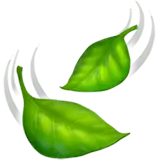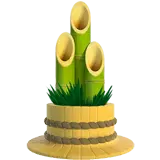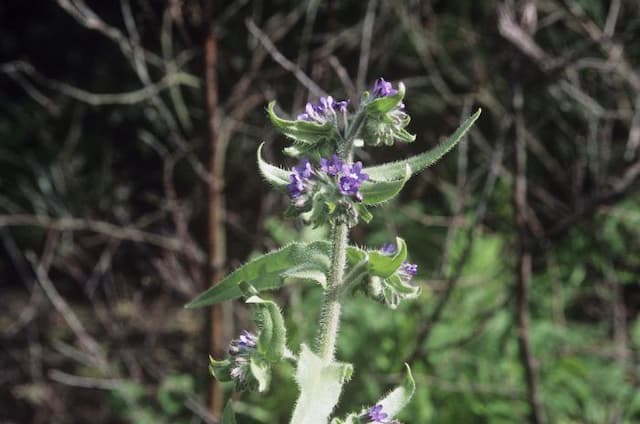Italian Bugloss Anchusa azurea

ABOUT
The plant commonly known as Italian Bugloss showcases a striking visual appeal with its vibrant blue flowers. These flowers have a funnel-like shape and are neatly clustered along the flowering spikes, creating a display that is both dense and ornamental. The petals have a slight curl at the edges, adding to their charm. Beneath the blooms, the plant sports hairy leaves that have a rough texture and a lance-like form, providing a lush green backdrop that highlights the intensity of the blue above. The leaves are arranged alternately along the stems, which are also hairy, giving the whole plant a somewhat fuzzy appearance. The Italian Bugloss makes a rich tapestry of blues and greens in the garden, presenting a picturesque sight when in full bloom.
About this plant
 Names
NamesSynonyms
Italian Bugloss, Garden Anchusa, Large Blue Alkanet, Blue Alkanet
Common names
Anchusa italica, Anchusa barrelieri, Anchusa procera, Buglossoides arvensis var. arvensis, Lycopsis arvensis.
 Toxicity
ToxicityTo humans
Italian Bugloss (Anchusa azurea) is not widely reported as a toxic plant to humans. However, as with many plants, it could potentially cause mild irritation or allergic reactions in some individuals if ingested or handled. It is not considered edible and it is always advisable to exercise caution and avoid ingesting plants not known to be safe for consumption.
To pets
Italian Bugloss (Anchusa azurea) is not commonly listed as a toxic plant to pets. However, ingestion of any non-food plant can potentially result in gastrointestinal upset such as vomiting or diarrhea in pets. If you suspect your pet has ingested this plant, it is best to consult with a veterinarian, especially if any symptoms or unusual behavior occurs.
 Characteristics
CharacteristicsLife cycle
Perennials
Foliage type
Deciduous
Color of leaves
Green
Flower color
Blue
Height
3-4 feet (0.9-1.2 meters)
Spread
1-3 feet (0.3-0.9 meters)
Plant type
Herb
Hardiness zones
3-8
Native area
Mediterranean
Benefits
 General Benefits
General Benefits- Attracts Pollinators: Anchusa azurea is known for attracting bees, butterflies, and other beneficial insects which are essential for the pollination of many plants.
- Aesthetic Appeal: With its striking blue flowers, it adds visual interest and beauty to gardens and landscapes.
- Drought Tolerance: Once established, it's tolerant of drought, making it suitable for xeriscaping and water-efficient gardening.
- Soil Enrichment: It can help improve soil quality by adding organic matter as leaves and stems decompose.
- Erosion Control: The plant's root system can help stabilize soil and prevent erosion, especially in sloped areas.
- Wildlife Habitat: It provides shelter and nectar for wildlife, supporting local ecosystems.
- Culinary Uses: Some parts of the plant have been used as a food coloring and have the potential to be used in culinary arts.
- Historical Significance: It has been used in traditional dyeing practices, giving historical value to crafts and textiles.
- Low Maintenance: It doesn’t require much care once established, making it an easy addition for gardeners of all skill levels.
- Fast Growth: Anchusa azurea grows relatively quickly, allowing for rapid establishment and coverage in suitable areas.
 Medical Properties
Medical Properties- Diuretic: Anchusa azurea has been traditionally used for its diuretic properties to help increase urine production.
- Emollient: The plant has been known to have soothing effects on the skin and was traditionally used to soften and protect the skin.
- Expectorant: It has been used to help clear mucus from the respiratory tract, easing coughs.
- Anti-inflammatory: There are indications that Anchusa azurea may contain compounds with anti-inflammatory effects.
- Vulnerary: The plant has been used traditionally for promoting wound healing and as an aid in the repair of skin tissue.
 Air-purifying Qualities
Air-purifying QualitiesThis plant is not specifically known for air purifying qualities.
 Other Uses
Other Uses- Anchusa azurea, commonly known as Italian Bugloss, has been used historically as a natural dye for textiles, imparting a red or blue color depending on the mordant used.
- In some regions, the flowers of Italian Bugloss are used to decorate and add color to salads and desserts, as they are both striking in color and edible.
- The plant can be employed in landscape gardening, providing a vivid blue accent in rock gardens, borders, and wildflower meadows.
- Italian Bugloss can serve as a companion plant due to its tall stature, offering support for weaker plants or climbers in the garden.
- The vibrant blossoms of Italian Bugloss are used in the cut-flower industry, often included in bouquets for their striking blue hue.
- Its robust nature allows it to be used for soil erosion control on banks and slopes where other plants might not thrive.
- Italian Bugloss can be integrated into permaculture systems as part of a biodiversity strategy, attracting pollinators like bees and butterflies to the area.
- In some traditional crafts, the flowers are used to impart color to natural fibers like wool before spinning into yarn.
- Gardeners may use Italian Bugloss as a dye for mulches or wood chips, contributing to a more aesthetic gardening experience.
- Educational activities, such as teaching about plant biology or natural dye processes, can utilize Italian Bugloss as a hands-on resource.
Interesting Facts
 Feng Shui
Feng ShuiThe Italian Bugloss is not used in Feng Shui practice.
 Zodiac Sign Compitability
Zodiac Sign CompitabilityThe Italian Bugloss is not used in astrology practice.
 Plant Symbolism
Plant Symbolism- Forsaken Love: Anchusa azurea, commonly known as Italian Bugloss, is sometimes associated with the theme of forsaken or forgotten love, perhaps due to the deep blue of its flowers that can evoke a sense of melancholy.
- Delicate Beauty: The rich color and delicate structure of Italian Bugloss's blooms can symbolize the fragility and exquisite beauty of nature, reminding beholders to appreciate the subtle beauties that may be easily overlooked.
- Remembrance: In some traditions, the color blue is connected with memory and remembrance. Thus, Italian Bugloss can be representative of keeping memories alive or longing for the past.
 Water
WaterItalian Bugloss should be watered deeply once every one to two weeks, depending on weather conditions, allowing the soil to dry out somewhat between waterings. In hotter, drier periods, you may need to water weekly, while in cooler, wetter months, watering frequency should be reduced. When watering, aim to apply the water directly to the soil around the roots rather than overhead, to avoid wetting the foliage. A thorough watering might involve applying approximately 1 to 2 gallons of water to the base of each plant, ensuring that the root zone is adequately moistened.
 Light
LightItalian Bugloss prefers full sun conditions to thrive, with at least six to eight hours of direct sunlight each day. Place the plant in a spot where it can receive ample light without being shaded by larger plants or structures. An open area that receives full, unobstructed sunlight is ideal for encouraging healthy growth and vibrant blooms.
 Temperature
TemperatureItalian Bugloss is hardy and can tolerate a range of temperature conditions, thriving in USDA zones 3 to 8. It can withstand minimum temperatures down to about -40 degrees Fahrenheit and is well-suited for growth in summer temperatures up to 90 degrees Fahrenheit. Ideal growing temperatures for Italian Bugloss are between 60 and 75 degrees Fahrenheit during the growing season.
 Pruning
PruningItalian Bugloss should be pruned to remove spent blooms and encourage further flowering. Pruning can be done throughout the blooming season as old flower spikes fade. Deadheading the plant, or removing the dead flowers, helps to maintain a tidy appearance and concentrates the plant's energy on producing new growth and flowers. The best time for more extensive pruning to shape the plant or reduce its size is in late winter or early spring before new growth begins.
 Cleaning
CleaningAs needed
 Soil
SoilItalian Bugloss prefers well-draining soil with a slightly acidic to neutral pH of 6.0 to 7.0. A mixture of loamy soil, sand, and compost will provide the drainage and nutrients needed.
 Repotting
RepottingItalian Bugloss typically does not require frequent repotting and can be done every 2-3 years to refresh the soil or if the plant outgrows its current container.
 Humidity & Misting
Humidity & MistingItalian Bugloss thrives in average room humidity. It does not require high humidity levels; normal outdoor conditions are usually adequate for this plant's health.
 Suitable locations
Suitable locationsIndoor
Place Italian Bugloss in a sunny spot with well-draining soil.
Outdoor
Plant Italian Bugloss in full sun with well-drained soil.
Hardiness zone
Italian Bugloss is suitable for USDA zones 3-8.
 Life cycle
Life cycleAnchusa azurea, commonly known as Italian Bugloss, begins its life cycle when seeds germinate in the spring, preferring well-drained soil and a sunny location. Seedlings grow into rosettes of hairy, lance-shaped leaves, which later develop a sturdy, branched stem. By late spring to early summer, the plant starts to bloom with clusters of vivid blue, funnel-shaped flowers, which are pollinated by bees and other insects. After pollination, the flowers produce small nutlets as fruits, which house the seeds for the next generation. As a perennial, Italian Bugloss may die back in the winter, especially in colder climates, but it will regrow from the rootstock the following spring. Over time, the plant can spread and form clumps, sometimes living several years and continuing its life cycle through self-seeding.
 Propogation
PropogationPropogation time
Spring-early summer
The Italian Bugloss can be propagated through seed sowing, which is the most popular method. The best time to sow seeds is in early spring after the risk of frost has passed, or they can be started indoors 6-8 weeks before the last frost date. To propagate by seed, simply scatter the seeds onto a well-draining soil mix and lightly cover with soil. Keep the soil moist but not waterlogged to encourage germination. Seedlings usually appear within 2-3 weeks, and they can be transplanted outdoors once they have developed a couple of sets of true leaves and are sturdy enough to handle the conditions in the garden.









